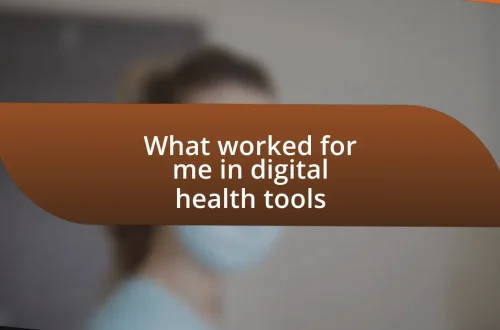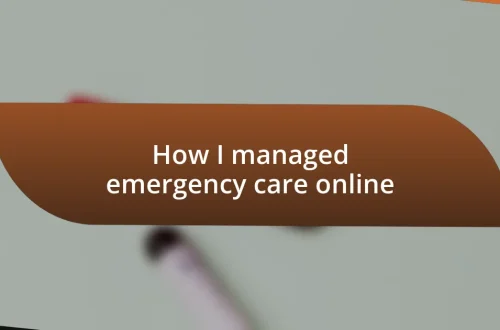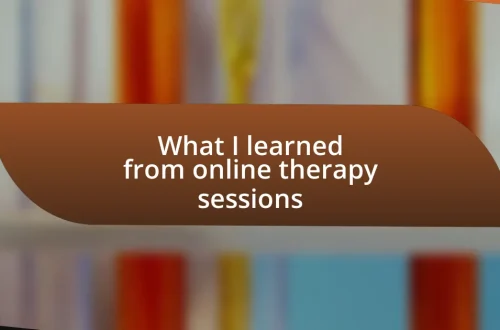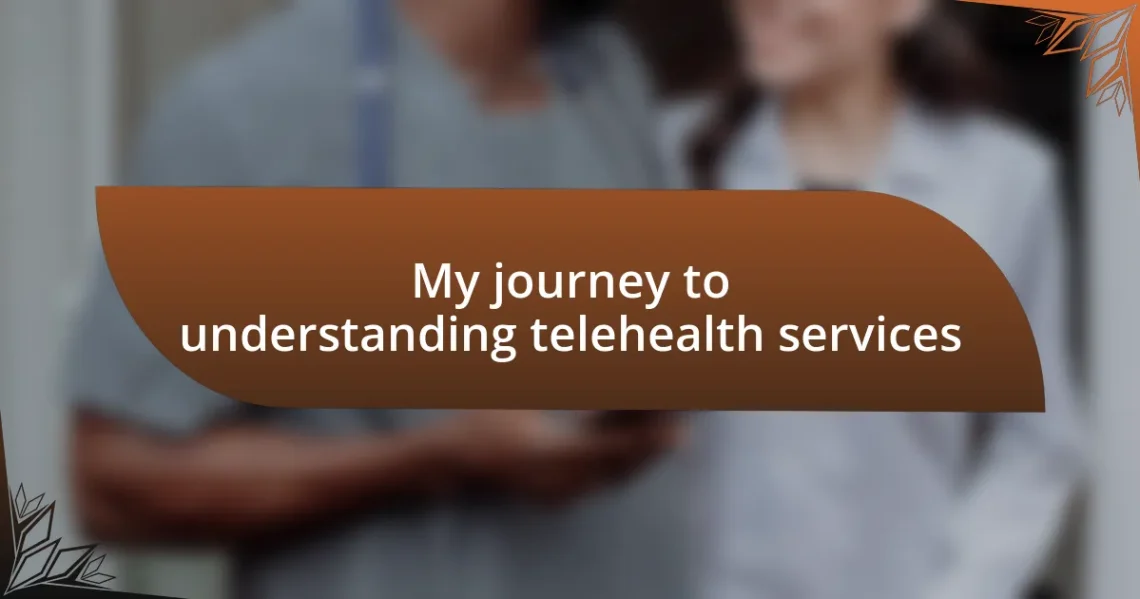
My journey to understanding telehealth services
Key takeaways:
- Telehealth services transform healthcare access through digital technologies, enabling remote consultations and monitoring.
- The benefits of telehealth include convenience, emotional comfort, and continuity of care, enhancing patient engagement and health management.
- Challenges such as technology access, technical issues, and privacy concerns must be addressed to improve telehealth effectiveness.
- Regulatory considerations, including state licensing and privacy compliance, are crucial for building trust and ensuring patient satisfaction in telehealth services.
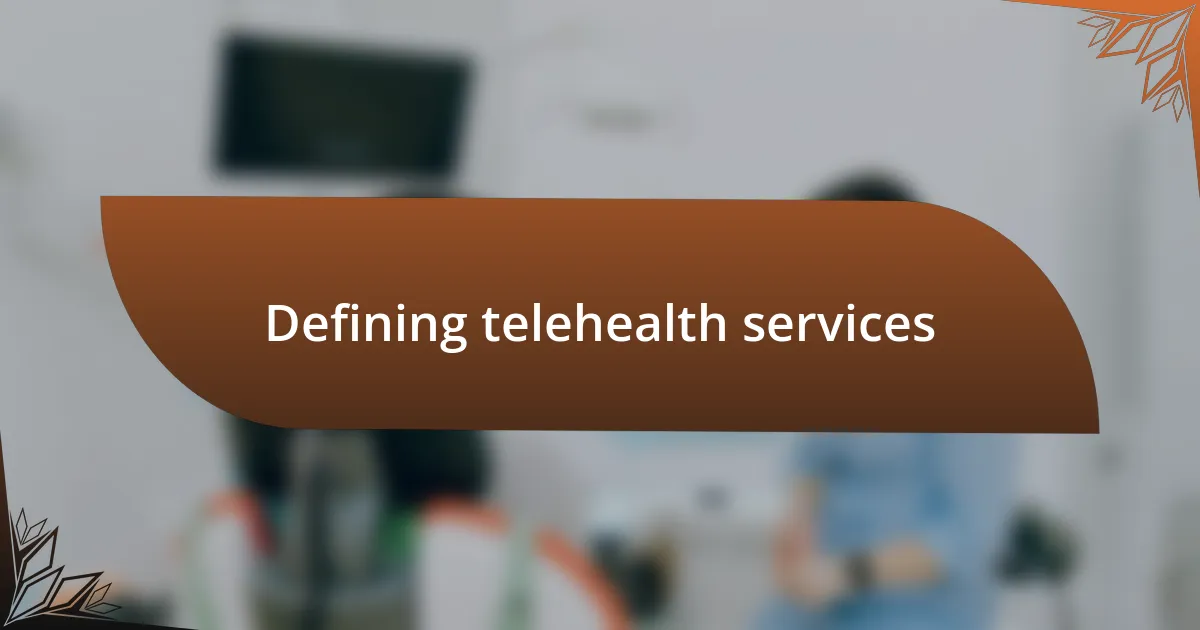
Defining telehealth services
Telehealth services refer to the delivery of healthcare using digital communication technologies. This can include video calls, phone consultations, and even remote monitoring of health data. It’s fascinating to think about how these services have completely transformed the way we access healthcare, isn’t it?
From my perspective, telehealth isn’t just about convenience; it also democratizes access to medical care. I recall a time when my elderly neighbor struggled to get to her appointments due to transportation issues. Telehealth opened up a world where she could consult with her doctor from the comfort of her home, alleviating her anxiety and enhancing her wellbeing.
Moreover, telehealth isn’t limited to routine check-ups. It encompasses mental health services, specialist consultations, and chronic disease management. Have you ever considered how profoundly telehealth can reshape the patient experience? In my experience, being able to communicate openly with healthcare providers from anywhere can lead to more honest discussions and better health outcomes.

Exploring telehealth benefits
The convenience of telehealth can’t be overstated. I remember a particularly hectic week when a mild illness struck me just before a crucial deadline. Instead of waiting for hours in a crowded office, I simply logged into a telehealth appointment, assessed my symptoms with my doctor, and walked away with a prescription—all in under 30 minutes. It felt like a breath of fresh air during a demanding time.
Furthermore, I’ve noticed that telehealth services often lead to greater continuity of care. For example, when my family member was managing multiple health conditions, having virtual follow-ups allowed her to stay closely connected with her healthcare team. This immediate access meant that she could promptly adjust her treatment plan based on her evolving needs, and it truly showcased how telehealth can foster proactive health management.
Interestingly, the emotional comfort that telehealth provides shouldn’t be overlooked. I often think back to a friend who faced anxiety and found talking to her therapist via video much easier than in-person visits. It created a space where she felt safe, enabling her to open up more freely. From my experience, this underscores how telehealth not only expands access but can also enhance the quality of care by prioritizing the patient’s emotional well-being.
| Benefit | Description |
|---|---|
| Convenience | Access to healthcare from anywhere without the need for travel. |
| Continuity of Care | Facilitates ongoing communication between patients and healthcare providers for better health management. |
| Emotional Comfort | Can create a more comfortable environment for discussing personal health issues, particularly in mental health. |
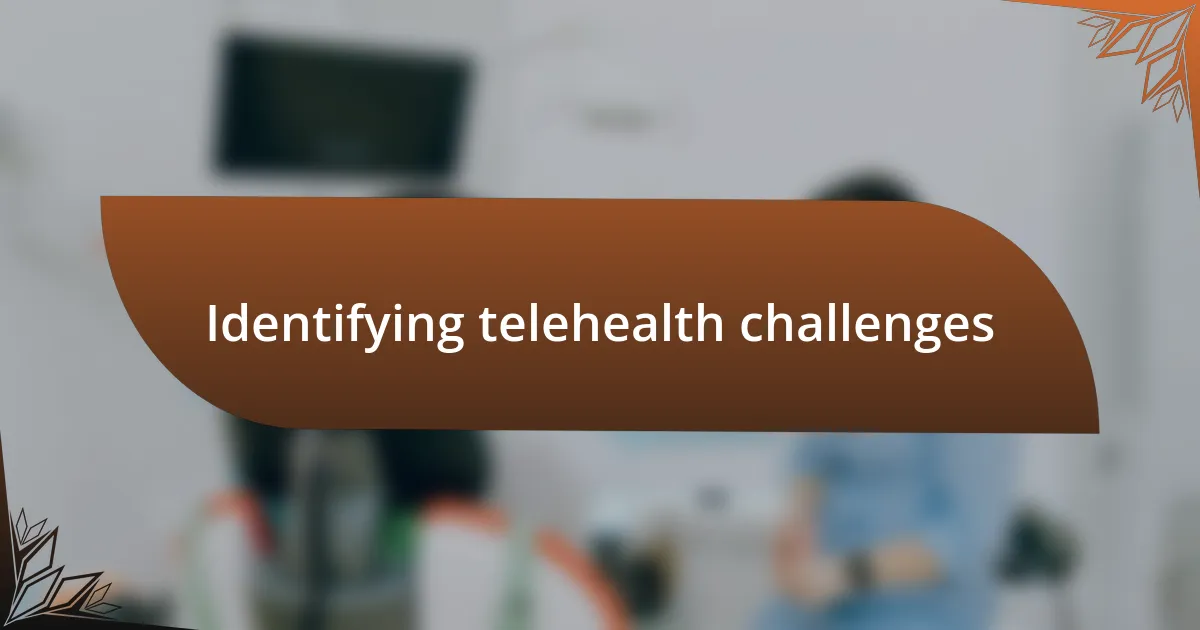
Identifying telehealth challenges
Identifying the challenges of telehealth is crucial for understanding its overall effectiveness. One major hurdle I encountered was the variability in technology access. When my neighbor attempted to schedule a virtual check-up, she struggled with unreliable internet connectivity. This highlighted how not everyone has the same resources, which can lead to disparities in care.
Here are some common challenges that patients and providers might face with telehealth:
- Technical Difficulties: Issues like poor internet connection or software glitches can interfere with appointments.
- Limited Physical Examination: Some health assessments require in-person evaluations which telehealth cannot fully replicate.
- Patient Engagement: For some, connecting via screen can feel impersonal, making it challenging to build rapport.
- Privacy Concerns: Patients may worry about the security of their personal health information during virtual consultations.
- Insurance Coverage: Not all insurance plans fully cover telehealth services, which can limit access for some patients.
Recognizing these obstacles is essential for improving telehealth services. During one appointment, the doctor had to guide me through technical issues, which added a layer of frustration. It’s moments like these that remind me that while telehealth has immense potential, it’s not without its bumps in the road.
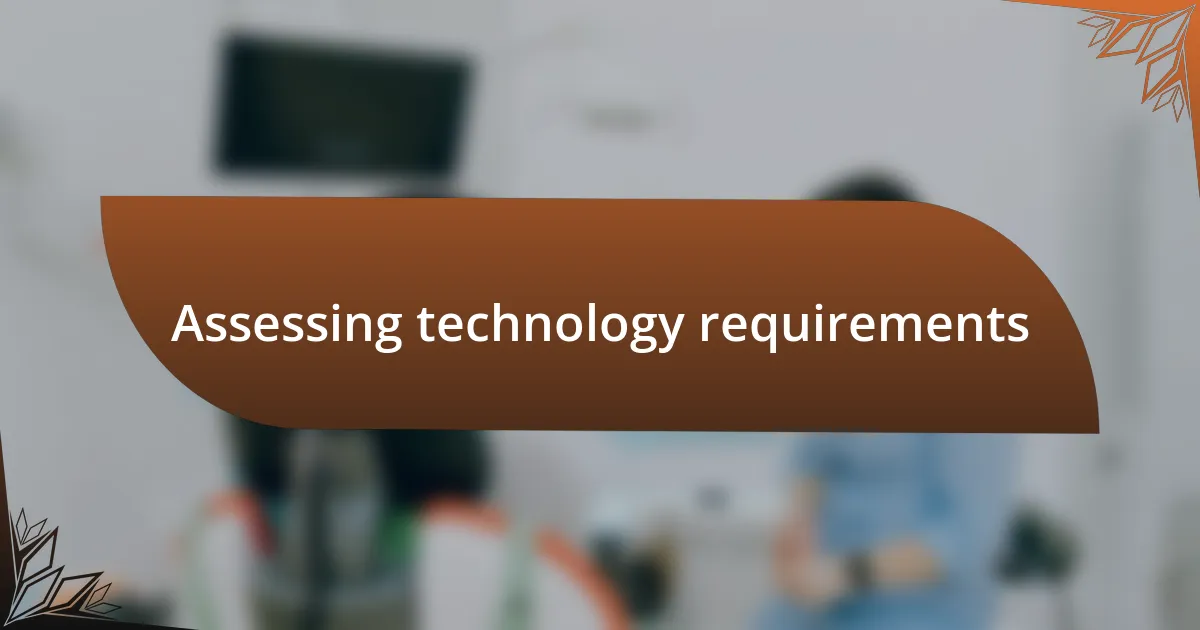
Assessing technology requirements
Assessing technology requirements for telehealth is more than just checking off a list; it’s a matter of figuring out what resources you truly need to connect effectively. I remember the first time I tried a telehealth appointment and realized I was using an outdated laptop with a poor webcam. Did I ever think that the quality of my device could impact my health care experience? It sure did.
When evaluating technology needs, consider factors like internet bandwidth and device compatibility. I’ve learned the hard way that having a stable connection is essential. On one occasion, an unstable Wi-Fi signal cut off my doctor mid-sentence, making an already sensitive conversation feel even more awkward. It’s frustrating to navigate these challenges, but recognizing them is the first step toward finding better solutions.
Lastly, don’t overlook the importance of user-friendly applications. Technology should enhance your experience, not complicate it. I once downloaded an app that was so complicated I felt more lost than informed. Asking for recommendations from others helped me find platforms that were intuitive and made my interactions smoother. Reflecting on these moments reveals how pivotal the right technology can be in ensuring we receive the care we deserve through telehealth.
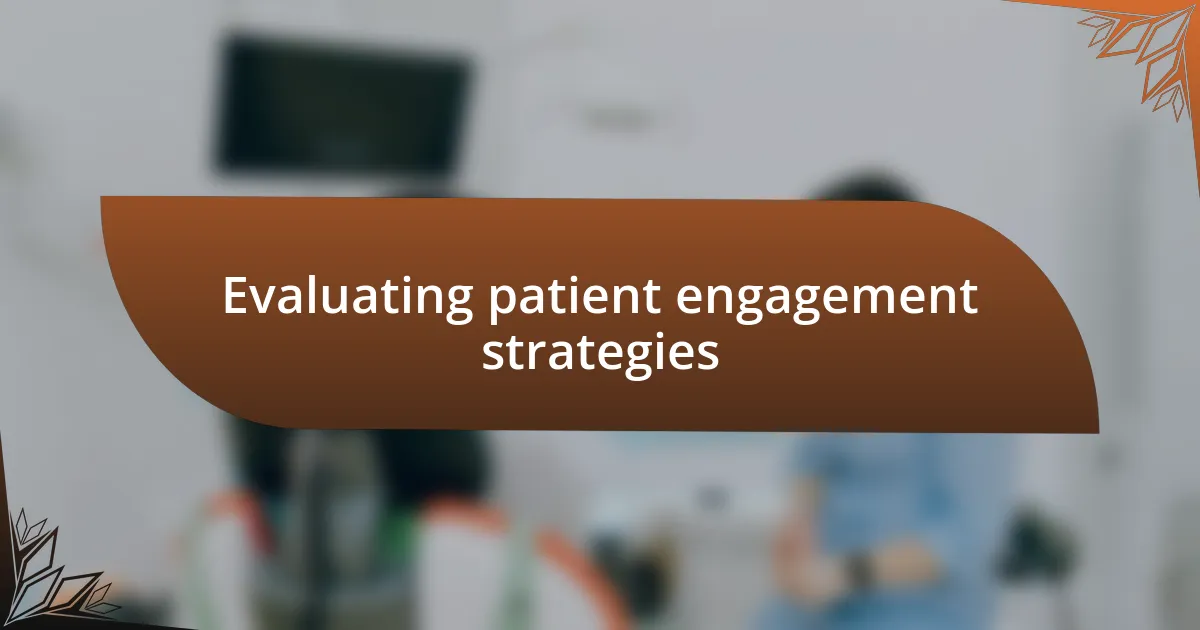
Evaluating patient engagement strategies
When it comes to evaluating patient engagement strategies, I think about how crucial communication is in telehealth. For instance, during my own experiences, I found that clear and consistent messaging from my healthcare provider helped me feel more at ease. Have you ever felt overwhelmed by medical jargon? I certainly have, and I appreciate when my doctor takes the time to explain things in a friendly, simple way.
Moreover, engagement goes beyond just communication; it’s also about understanding the patient’s needs and preferences. There was a time when my provider offered multiple channels for follow-ups like texts, emails, and calls. I felt empowered to choose the method that worked best for me. Wouldn’t you agree that having options creates a more personalized experience?
Lastly, I’ve realized that feedback mechanisms play a critical role in enhancing patient engagement. After sharing my thoughts on a telehealth visit, my provider implemented some changes that made future appointments smoother. It made me feel valued and part of the process. Don’t you think that when we feel we have a voice, it strengthens our commitment to our own health?
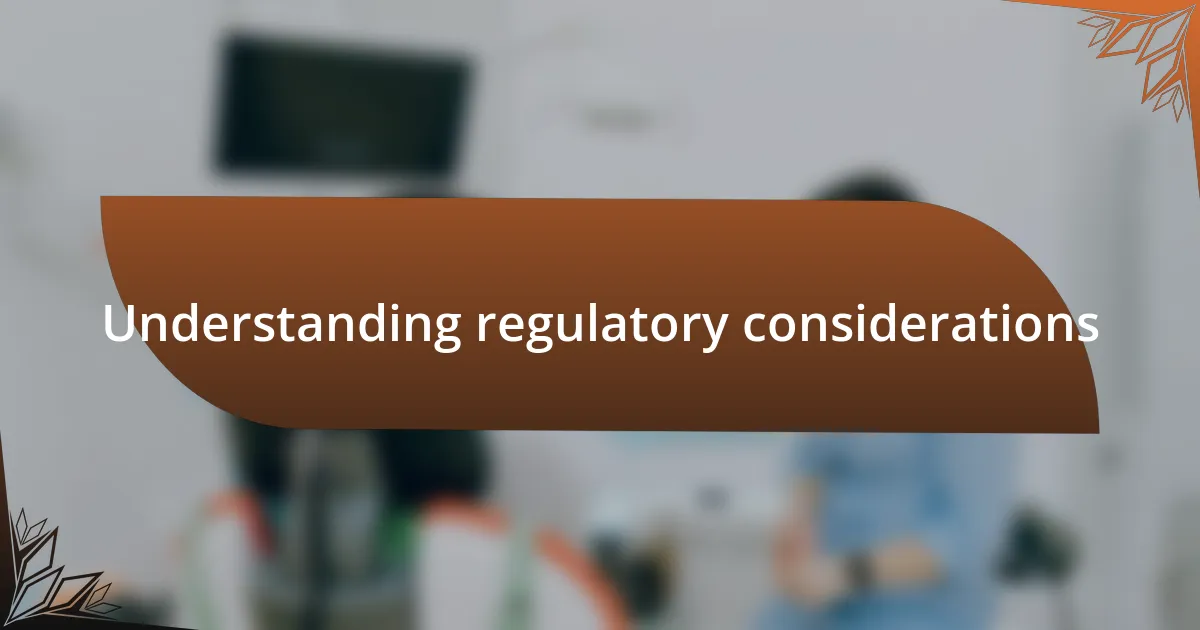
Understanding regulatory considerations
Navigating the regulatory landscape of telehealth services can be quite daunting. As I dove deeper into this world, I quickly realized that understanding state licensing requirements was crucial. Each state has its own rules regarding who can provide telehealth services, and I’ve often wondered how healthcare providers keep up with such diverse regulations. It’s a complex web, isn’t it?
In my experience, adhering to privacy regulations, particularly HIPAA, is non-negotiable. I remember a telehealth appointment where my provider reassured me that my information was secure. This not only alleviated my concerns but also reinforced my trust in the service. Don’t you think that confidence in confidentiality is what enables us to open up during these virtual visits?
Moreover, I came to appreciate the importance of billing and reimbursement policies for telehealth services. Initially, I was perplexed by how insurance coverage varied between in-person and virtual visits. During one appointment, my provider walked me through the process, helping me understand my financial responsibilities. It really highlighted for me how clarity in these policies can enhance patient satisfaction. Have you ever felt uncertain about billing, and noticed how it impacts your willingness to seek care?
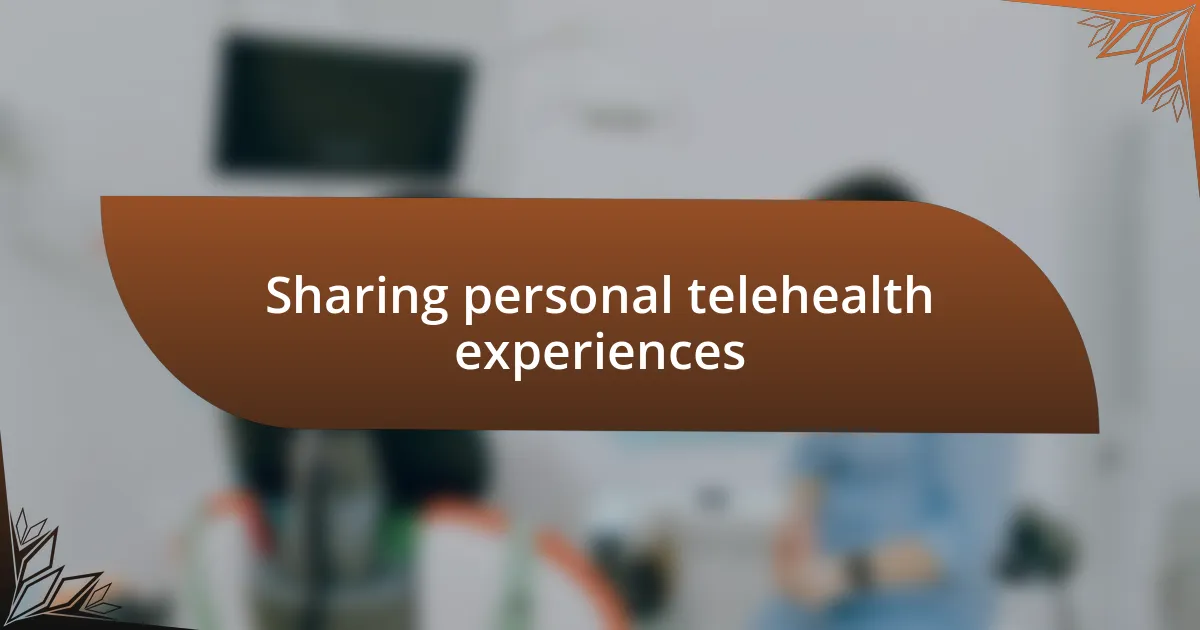
Sharing personal telehealth experiences
Sharing personal telehealth experiences can transform how we perceive and utilize these services. I recall my first telehealth appointment during a minor illness. Honestly, I felt a mix of skepticism and curiosity, wondering if a screen could match the personalized touch of an in-person visit. Yet, when the doctor greeted me with a smile and attentively listened to my symptoms, it dawned on me that empathy can transcend physical space.
Over time, I found that telehealth appointments not only saved me travel time but also allowed me to engage more openly. One time, I felt a bit anxious about discussing a sensitive issue, but the familiar comfort of my home made it easier to voice my concerns. Have you ever noticed how the environment affects our willingness to be vulnerable? It’s fascinating how being in a safe space can lead to more honest conversations.
I also discovered the convenience of follow-up care through telehealth. After a dental checkup, I received a video consultation to discuss my treatment options more thoroughly. It was incredibly reassuring to see my dentist’s face and ask questions directly after the exam. That level of accessibility made me appreciate telehealth even more. Doesn’t it feel empowering when your healthcare providers adapt to your needs?


